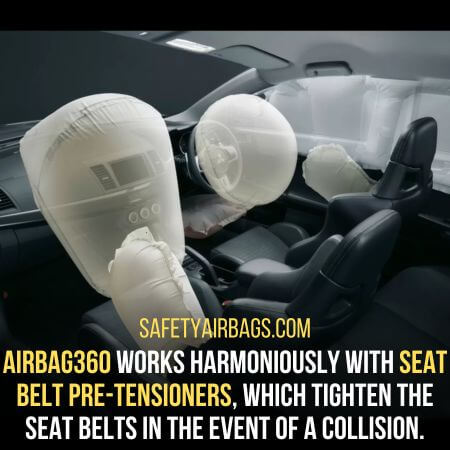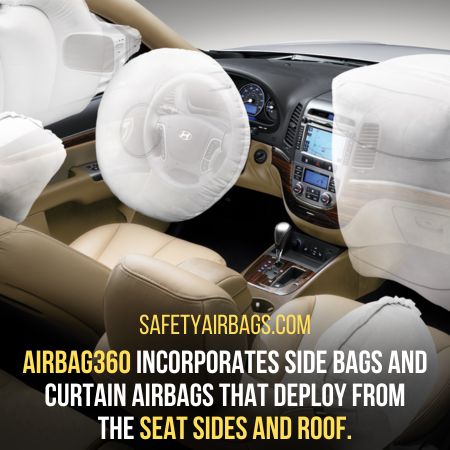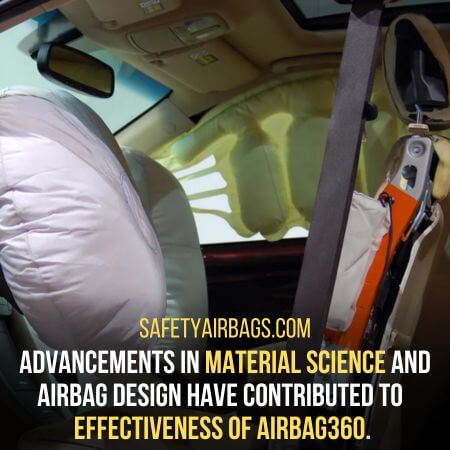Does Airbag360 work? With its advanced features and potential to enhance occupant protection, Airbag360 promises to be a game-changer in the automotive industry.
What Will I learn
This article will explore the world of automotive safety systems and the revolutionary technology known as Airbag360.
Does Airbag360 Work? Understanding Airbag360
Airbag360 is an advanced airbag system that goes beyond the traditional concept of frontal airbags.
Therefore, it is safe to say that Airbag360 works effectively in cases of accident.
While standard airbags primarily focus on frontal collisions, Airbag360 provides comprehensive protection in multiple accidents.

It can include frontal collisions, side impacts, and rollovers. It achieves this through strategically placed airbags throughout the vehicle’s cabin.
The system utilizes sensors that continuously monitor vehicle speed, acceleration, braking, and yaw rate.
These sensors provide real-time data to the Airbag360 control unit. It analyzes the information and determines the optimal deployment of airbags in different scenarios.
In the event of an accident, the Airbag360 system rapidly deploys the necessary airbags to cushion and protect the occupants.
Components And Sensors Involved In The System:
The Airbag360 system comprises several key components and sensors working together to ensure effective occupant protection. These include:
1. Crash Sensors: These sensors detect the Impact or deceleration caused by a collision and trigger the deployment of airbags.
2. Occupant Sensors: These sensors determine the presence, position, and weight of occupants in different seating positions, allowing for customized airbag deployment.
3. Vehicle Dynamics Sensors: These sensors monitor various parameters related to the vehicle’s motion.
It involves speed, acceleration, and yaw rate, providing crucial data for the control unit to make accurate deployment decisions.
4. Control Unit: The Control Unit serves as the brain of the Airbag360 system.
It receives sensor data, analyzes it in real-time, and activates the appropriate airbags to protect the occupants.
Airbags: Airbag360 employs a comprehensive range of airbags strategically positioned throughout the vehicle’s cabin, including front, side, curtain, and knee airbags.
This multi-dimensional approach ensures maximum protection in various crash scenarios.
Integration With Existing Safety Features:
Airbag360 is designed to integrate with existing safety features in modern vehicles seamlessly.
It works with seat belts, electronic stability control systems, anti-lock braking systems, and other advanced safety technologies.
It provides a comprehensive safety net for vehicle occupants. The integration with seat belts is particularly noteworthy.

Airbag360 works harmoniously with seat belt pre-tensioners, which tighten the seat belts in the event of a collision.
It keeps the occupants firmly secured and enhances the effectiveness of the airbag system.
Furthermore, the Airbag360 control unit considers the seat belt usage status when deploying airbags.
For example, if a front seat occupant is not wearing a seat belt, the system may deploy the airbags differently to provide optimal protection.
This integration with existing safety features ensures that Airbag360 enhances the overall effectiveness of the vehicle’s safety system.
It provides an advanced and comprehensive approach to occupant protection.
Benefits Of Airbag360
Airbag360 offers a significant enhancement in the level of protection provided to vehicle occupants compared to traditional airbag systems
1. Enhanced Protection For Vehicle Occupants:
By deploying multiple airbags strategically throughout the cabin, Airbag360 ensures that the impact forces are distributed more evenly, reducing the risk of severe injuries.
The comprehensive coverage of airbags in Airbag360 provides enhanced protection for the head, chest, pelvis, and legs.
It minimizes the risk of critical injuries in various crash scenarios.
This advanced protection significantly increases the chances of survival and reduces the severity of injuries for vehicle occupants.
2. Reduction In Injuries And Fatalities:
One of the primary objectives of Airbag360 is to minimize injuries and fatalities resulting from automotive accidents.
With its multi-dimensional airbag deployment system, Airbag360 offers higher occupant protection, reducing the risk of severe injuries.
Studies and real-world evaluations have shown that Airbag360 has the potential to reduce the severity of injuries in different types of accidents.
It includes frontal collisions and side impacts. Airbag360 can mitigate the force exerted on the body and decrease the likelihood of life-threatening injuries.
It effectively cushions and restrains the occupants during a crash.
Reducing injuries and fatalities attributed to Airbag360 can bring substantial social and economic benefits.
These include lower healthcare costs, reduced trauma, and improved road safety.
3. Impact On Different Types Of Accidents (e.g., Frontal Collisions, Side Impacts):
Airbag360’s ability to provide comprehensive protection extends to various types of accidents.
This can include frontal collisions and side impacts, which are known to result in significant injuries and fatalities.
In frontal collisions, Airbag360 ensures that the front airbags deploy in a controlled manner to protect the driver and front passenger.

The system considers occupant size, position, and seat belt usage to optimize airbag deployment, reducing the risk of head and chest injuries.
Regarding side impacts, Airbag360 incorporates side airbags and curtain airbags that deploy from the seat sides and roof, respectively.
These airbags protect the occupants’ heads and torsos, minimizing the risk of severe injuries caused by intruding on another vehicle or object.
By effectively addressing the specific challenges posed by different types of accidents, Airbag360 enhances occupant protection and overall safety in various crash scenarios.
Technical Challenges and Solutions
While traditional airbag systems have effectively mitigated injuries in frontal collisions, they have certain limitations that Airbag360 aims to overcome.
1. Overcoming Limitations of Traditional Airbag Systems:
Standard airbags primarily focus on protecting the occupants in front-end collisions and may not provide sufficient protection in side impacts or rollovers.
Airbag360 addresses these limitations by strategically placing additional airbags throughout the vehicle’s cabin.
This comprehensive coverage ensures that occupants are protected in various accidents, reducing the risk of severe injuries.
Furthermore, standard airbags are designed to deploy with a certain force, which can sometimes cause injuries.
It is especially for smaller occupants or those sitting closer to the airbag.
Airbag360 incorporates advanced sensors and control algorithms to tailor the deployment force based on occupant size, position, and seat belt usage.
This customization improves occupant safety and minimizes the risk of unnecessary injuries.
2. Integration Challenges with Various Vehicle Models:
Integrating Airbag360 with different vehicle models poses a significant challenge due to variations in vehicle structures, interior layouts, and electronic systems.
Therefore, each vehicle model requires careful consideration and customization to ensure optimal performance and compatibility with Airbag360.
Manufacturers must conduct rigorous testing and analysis to determine the ideal placement of airbags.
They must consider factors such as crash dynamics, occupant positions, and structural characteristics of each vehicle model.
This integration process involves collaboration between airbag system developers and automobile manufacturers to ensure seamless integration and efficient operation.
Furthermore, various vehicle models’ electronic architecture and communication protocols can differ, presenting integration challenges.
Airbag360 developers work closely with automobile manufacturers to establish compatibility.
They implement the necessary protocols to ensure reliable and efficient communication between the Airbag360 system and the vehicle’s onboard systems.
3. Innovative Solutions and Advancements in Technology:
Developers have implemented innovative solutions and technological advancements to overcome the technical challenges associated with Airbag360.
Advanced sensor technology plays a crucial role in the success of Airbag360.
Manufacturers have developed high-precision sensors that accurately detect crash forces, occupant positions, and other critical parameters.
In addition, these sensors provide real-time data to the control unit, enabling precise and timely airbag deployment.
Furthermore, control algorithms and computing power advancements have enabled more sophisticated analysis and decision-making within the Airbag360 system.
The control unit can process vast sensor data in real-time and make optimized deployment decisions based on the specific crash scenario and occupant characteristics.

Additionally, advancements in material science and airbag design have contributed to the effectiveness of Airbag360.
As a result, manufacturers have developed airbags with improved structural integrity and inflation characteristics.
It allows for better distribution of forces during a crash and minimizes the risk of injuries.
Collaboration between airbag system developers, automobile manufacturers, and regulatory bodies is crucial for driving continuous technological advancements.
Ongoing research and development efforts aim to refine Airbag360 further and address emerging challenges to ensure enhanced occupant protection and safety.
Airbag360 In Comparison To Traditional Airbags
Airbag360 offers several key differences and advantages over conventional airbag systems, making it a significant advancement in occupant protection.
1. Comprehensive Protection:
Unlike standard airbags primarily focusing on frontal collisions, Airbag360 provides comprehensive protection in various accidents.
These include frontal collisions, side impacts, and rollovers. The strategically placed airbags throughout the cabin ensure enhanced coverage and minimize the risk of injuries.
2. Customized Deployment:
Airbag360 incorporates advanced sensors and control algorithms to tailor the deployment of airbags based on factors such as occupant size, position, and seat belt usage.
This customization optimizes occupant safety and reduces the risk of unnecessary injuries.
3. Enhanced Safety Features:
Airbag360 integrates with existing safety features, such as seat belts, electronic stability control systems, and anti-lock braking systems.
It provides a comprehensive safety net for vehicle occupants. The integration enhances the overall effectiveness of the vehicle’s safety system.
Conclusion:
In conclusion, Airbag360 represents a significant advancement in automotive safety systems.
It has comprehensive protection, customized deployment, integration with existing safety features, and ongoing technological advancements.
Airbag360 offers enhanced occupant protection. It can potentially reduce injuries and fatalities in various types of accidents.
As the technology continues to evolve and become more cost-effective, Airbag360 holds great promise for improving road safety and saving lives.
